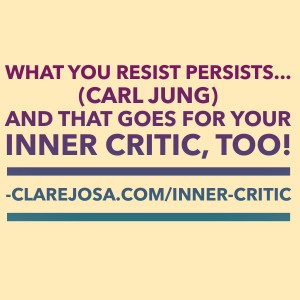 We all know that feeling… You’re totally fired up and about to start doing something really important and you know it’s a bit of a comfort zone stretch… And that little voice in your head starts talking… It’s telling you all the reasons why you won’t be any good at it and how you’re never any good at anything… And you know you believe it, because it’s told you often enough over the years… You feel that tightness in your stomach, your body tenses and you feel fear and panic rising…
We all know that feeling… You’re totally fired up and about to start doing something really important and you know it’s a bit of a comfort zone stretch… And that little voice in your head starts talking… It’s telling you all the reasons why you won’t be any good at it and how you’re never any good at anything… And you know you believe it, because it’s told you often enough over the years… You feel that tightness in your stomach, your body tenses and you feel fear and panic rising…
But it doesn’t have to be that way.
You don’t have to live on the whim of your Inner Critic – your negative self-talk – you can tame it – today. And it’s surprisingly easy, when you know how.
But, before we start:
How do you know if you’ve got an Inner Critic?
You’ll KNOW if you run an Inner Critic programme. The most common side effects include:
- Low self-esteem – you beat yourself up each time you try to do something important and it’s fantastic at reminding you about your mistakes
- Stress – your Inner Critic is responsible for the vast majority of stress in your life
- Self-sabotage – just when you’re about to achieve what you have been dreaming of, your Inner Critic leaps in and pulls the rug from under you
- Insomnia – if you’re lying awake at 3am, then chances are it’s your Inner Critic choosing the bedtime stories
- Feeling exhausted – your Inner Critic is running the show on everything from your physical health and your energy levels, through to your emotional and mental health
- ‘Ok-ness’ – the Inner Critic is the biggest single reason why most of us put up with a life that’s ‘ok’, rather than ‘great’
- Guilt – your Inner Critic is incredible at reminding you about all the things you didn’t do or the ways you let people down (its words, not mine!)
Some of my clients and students go so far as to call their Inner Critic their ‘own worst enemy’. Strong stuff.
Feels familiar? Are you fed up enough of it yet? Then here are five techniques you can use today to tame that critic and move on with a happier life!
Is it time to tame your Inner Critic?
Here are 5 sure-fire techniques you can use today.
I have been where you are with my Inner Critic – and it sometimes pops back and reminds me it’s there, when I least suspect it. But, fortunately, after over a decade as an NLP Trainer and a Meditation Teacher, as well as being a reformed Mechanical Engineer, I have developed plenty of practical strategies to handle it – fast.
Here are five of my favourite ‘do-them-today’ techniques to help you to tame your Inner Critic and to set yourself free from its negativity.
-
 Fact: You are not the same as your inner critic. It is ‘just’ a thought in your head.
Fact: You are not the same as your inner critic. It is ‘just’ a thought in your head.Let’s start by setting the record straight: although most of us identify pretty strongly with our inner critics, we are not the same thing as our critic. It is JUST a train of thought – a sound-track that we’re used to playing.
No matter how it might feel, it isn’t actually real.
When you realise that, it gives you the power to make changes.
But while you’re falling into the trap of believing that you and your inner critic are one-and-the-same being, then it will always hold the power.Quick Fix: When you feel an Inner Critic thought coming up, press pause (yes, you can do that) and remind yourself: “This is not who I am. This is a thought I am thinking,” and let it go. Feel the relief bubbling up.
-
 Don’t make the mistake of fighting it!
Don’t make the mistake of fighting it!I’m not suggesting you indulge your Inner Critic’s every whim. But I AM strongly suggesting you don’t out-right reject it, fight it or try to ‘get rid’ of it. Why?
Because, as Carl Jung pointed out:What you resist persists – and that goes for your Inner Critic, too.
So if you fight your Inner Critic, you are resisting it. That means you’re giving it loads of attention, you’re giving it 100% of your head space (free rent!) and you’re spending loads of time thinking about it.
Like a tantruming child, feed that Inner Critic and it’ll learn to do more of what got it the attention it wanted. That’s why I talk about ‘taming’ your Inner Critic, rather than ‘getting rid’ of it. You’re retraining the part of you that runs it, instead of rejecting part of yourself, which will only ever lead to pain and conflict.
Quick Fix: When your Inner Critic gets ranting, stop what you’re doing and notice that it’s there (then it doesn’t need to shout so loudly). Say a silent, “Thank you,” (even if you don’t feel like it – but it’s the opposite of ‘rejecting’) and then consciously choose a happy thought.
If you’d like to discover how to become a total pro at this, then meditation and mindfulness could be your best friends.
-
 Stop feeding its pesky stories!
Stop feeding its pesky stories!Your Inner Critic loves drama and makes the nation’s favourite soap operas look dull, in comparison with the stories going on in your head. We all LOVE drama. That’s why people love to gossip. It’s why they love to share stories. The more dramatic, the better.
Unfortunately, when it comes to your Inner Critic’s stories, the more you feed them, the worse you feel and the further you move from that amazing life you have been dreaming of.
Quick Fix: Stop feeding the stories. When you feel an Inner Critic conversation coming on, press pause and consciously choose about whether you want to dive in to that drama, or whether you want to focus on something else instead.
It doesn’t matter how far you have gone into the ‘drama’ before you realise, you can always press pause and come on out again.
If you’re feeling stuck, right now, grab the nearest small object to you, pick it up in your hand and really see it – see how the light reflects on it, how the shapes and contours give it its form. Feel the weight of it in your hand. Feel the textures. And then – the icing on the cake – take a moment to connect with that object, from your heart, and to thank it for whatever it does for you. Aim to do this for about a minute in total and it will physically shift the biochemistry in your body, releasing endorphins and helping you to feel happier.
There. Story paused. And you can move on with a more empowering mood!
-
 Delete the word ‘should’ from your vocabulary.
Delete the word ‘should’ from your vocabulary.Yikes! That’s a biggie! How often do you use the word ‘should’ in a typical day? I should do such-and-such. I ought to go to that meeting, even though I don’t really want to. I should offer to help Fred this weekend…
It’s there like a naff theme tune in our day-to-day lives. But… How does ‘should’ make you feel?
I’m guessing it triggers a sinking feeling in your stomach, a slouching of your shoulders and back and a frown on your face.
And your Inner Critic is addicted to ‘should’ – because it knows it’s a great way to get our attention!
Quick Fix: If you feel ‘should’ coming up, pause and ask yourself:
“Who says?” and “Is that really true?”And let the answer bubble up. Notice what comes up for you and use it to gain insight into old auto-pilot behaviours that might have been keeping you stuck. Awareness is the first key to change – through choice. You can choose whether or not you want to respond to ‘should’ – or whether you want to make conscious choices about your thoughts, words and actions, instead.
-
 Psst! You don’t have to listen to it…
Psst! You don’t have to listen to it…Most of us listen slavishly to that negative self-talk, replaying it over and over, especially when we’re stressed.
But you don’t actually have to listen to it. Just because you’re having a thought, you don’t have to tune your radio to that frequency for the whole day. You CAN choose to turn down the volume and just let your Inner Critic get on with whatever it is complaining about, in the background. Here’s a scenario:
Quick Fix: Imagine a scene in a classic sit-com – the wife is ear-bashing her husband for some mistake he has made, he carries on calmly reading his newspaper (or nowadays Tablet) and nodding politely. When she has fully vented her spleen, she demands to know what her husband thinks of what she has said.
“That’s nice, Dear,” is the only response she gets.
He does get rattled. He doesn’t argue back. He totally rides the wave of her drama and annoys the hell out of her by refusing to dance the destructive dance.
What would happen if you were to play that game with your Inner Critic, once in a while? Give it a good old “That’s nice dear” and then ask it a question about something that moves things forwards, such as, “I’m wondering… What would you most like to do next?” And watch what happens!
Already a member? LoginThe rest of the five sure-fire techniques to tame your inner critic are only available to members of Dancing In Your Soul-Shoes.
Join us for Dancing In Your Soul-Shoes today and you’ll get my fabulous fortnightly newsletter – packed with practical inspiration that you can apply while the kettle boils – as well as membership of our private Facebook group.
Silver Membership normally costs £17 per month, but I’m feeling super-generous while we’re in the pre-launch phase (the bells and whistles arrive in Autumn 2014), so if you register today, it’s yours as my gift – for as long as you’re a member.
Woo hoo, %%FIRST_NAME%%! You get to read this article because you’re a member of Dancing In Your Soul-Shoes. Thank you! With love, Clare x
Time For Action!
So, which techniques are you going to use today? And when you have tried them out, let me know which shifts you notice, via the comments box, below.
If you enjoyed this article, please share it far and wide via Social Media – it’s my gift to you.
 Here’s a tweetable – to make it easy!
Here’s a tweetable – to make it easy!
Tweet this: Had enough of your inner critic yet? 5 sure-fire techniques to tame it today!
 And here’s an image you can share on Facebook – just click on it and click the ‘share’ link to spread the word about taming your Inner Critic!
And here’s an image you can share on Facebook – just click on it and click the ‘share’ link to spread the word about taming your Inner Critic!
Want More…?
I really hope you found these techniques useful. Of course, we’re just scratching the surface here. If you’re feeling inspired to dive in more deeply and deal with that pesky Inner Critic, once and for all, then make sure you’re watching your inbox this winter, because Taming Your Inner Critic will be one of the courses for my gorgeous Gold Members of Dancing In Your Soul-Shoes!
It’s a six week programme that will help you to deal with that pesky Inner Critic – once and for all. Woo hoo!
With love, Namaste,
